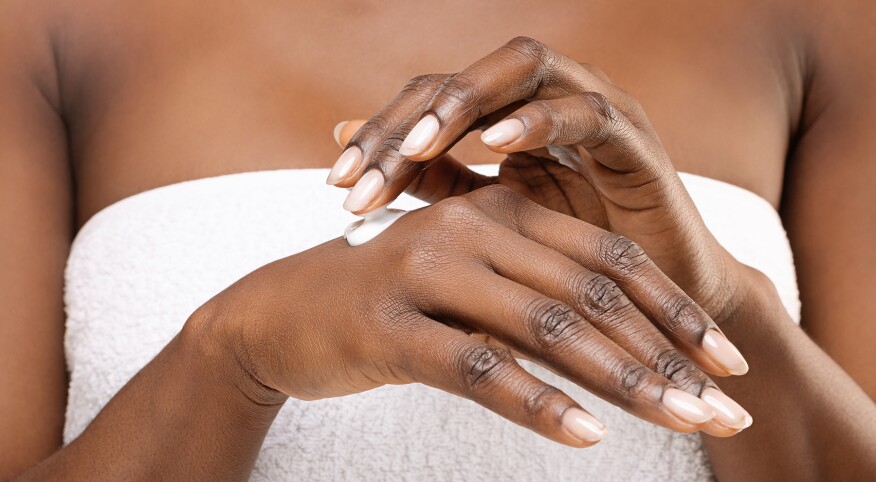I always get an ego boost when visiting my physician because I usually hear some version of “Black don’t crack.” But I try to hide my hands, because my hands don’t lie. Those snitches. Don’t take this as a sign I’m not proud of my age. It isn’t. Some people talk with their hands. But even if we don’t, the hands have a way of telling our story. We’ve lived, and changes that reveal the passage of time should be welcomed and celebrated. It’s the changes that happen with inadequate self-care that we want to keep in check. I recently learned that even those of us with an overall healthy lifestyle could stand to give our hardworking hands a little extra care.
As skin matures, there is a reduction in collagen production and it loses elasticity, say dermatologists. Plus, a loss of lipids (the skin’s natural fats) can contribute to dryness, flakiness or roughness/bumps, as well as a loss of volume and plumpness. Skin cell turnover slows down and dead skin isn’t sloughed off and replaced as quickly, leading to a dry, dull skin tone. Sun spots or dark spots, which have more to do with the accumulation of sun exposure than age, become noticeable.
These days, unfortunately, we’re subjecting our skin to even more irritants as protection against COVID-19. That means frequent handwashing. Hand sanitizer may protect us from viral bugs, but that recommended 60 percent alcohol sucks … moisture, that is, leading to severely dry skin. Hot water is drying to the skin as well, and if it’s too hot, can damage the skin’s protective surface layer.
“There are things that can be done to restore healthy skin on our hands and stop further damage.”
“Skin is our barrier to the outside world,” says dermatologist Brooke Jackson of Skin Wellness Dermatology Associates in Durham, North Carolina. When it is compromised through constant washing, she continues, hands can develop dry, itchy skin with tiny cracks that potentially allow bacteria and viruses to enter. This can make skin susceptible to irritation, rashes and conditions such as rosacea and eczema. “So maintaining skin-barrier function is crucial.”
8 little secrets for lovelier hands
Fortunately, there are things we can do to restore healthy skin on our hands and stop further damage. For beautiful hands, take a few minutes daily to treat them as carefully as you would your face.
- Use a gentle hand cleanser. “First, I recommend washing with a gentle cleanser,” says Tulsa, Oklahoma, dermatologist Kesha Buster of VibrantSkin Dermatology and Laser. Harsh cleansers like dishwashing detergent can irritate skin and exacerbate skin conditions like eczema.Cleansers from Vanicream, Cetaphil and Dove, for example, cleanse without stripping the skin of its moisture. Jackson’s additional tip is to stash a travel-size cleanser in your purse.
- Moisturize. The next step after washing, says Buster, is to pat your hands dry and while still moist, immediately apply a thick cream, or if the skin is really dry, an ointment, to lock in moisture. If you’re using hand sanitizer, once it dries, put on hand cream or ointment.
Moisturize your hands as needed throughout the day. Some ingredients to look for in hand creams are petrolatum, shea butter, glycolic acid and hyaluronic acid. When using moisturizers and ointments, rub it into the fingernails and cuticles, which also need to be kept hydrated to prevent dry cuticles and brittle nails. - Use sunscreen. “The easiest step to slow aging in the hands is use of broad-spectrum sunscreen starting early in life and consistently,” advises Buster. This will keep hands free from dark spots, uneven skin tone and wrinkles. If you get frequent manicures, warns Jackson, apply a sunscreen prior to drying your hands under the UV light.
- Wear driving gloves, suggests Jackson. Your hands are getting sun exposure while holding the steering wheel. Even consider wearing gloves when riding a bike, gardening or any activity where your hands will have prolonged exposure to the sun. And when that is not possible, make sure to apply sunscreen.
- Always wear waterproof gloves when washing dishes or using any cleaning products around the house, as the chemicals also dry out the skin. For extra protection, apply a hand balm before you put on the gloves to do any cleaning.
- Exfoliate the hands one to two times a week to slough off dead skin cells and help moisturizers penetrate the skin. This can include an at-home microdermabrasion scrub or device or a chemical peel done once a week to remove the top layer of skin, which will help fade and reduce dark spots. (If you have sensitive skin or are using a retinol product, consult a dermatologist before using a chemical peel.) For scaly, rough skin, use an exfoliating moisturizer. Buster recommends CeraVe SA Cream, which contains salicylic acid, or AmLactin Ultra Smoothing Intensely Hydrating Cream.
- At night, use a thick cream. “Apply petroleum jelly to seal in moisture at night and wear white cotton gloves or socks,” says Jackson. “Try this a few times a week to restore moisture.”
- Consider a once-a-week hand treatment containing retinol, applied at night to avoid sun exposure. (Retinol, which helps peel away damaged skin, also makes the skin photosensitive.) Retinol creams will improve crepey skin texture, as well as jumpstart the growth of collagen.
What about cosmetic treatments for veins or sagging skin?
You should see pleasing improvements with proper skin care. But if you’re looking for a more drastic transformation, consult a dermatologist. If you’re troubled by dark spots, for instance, he or she may prescribe a topical cream to help fade them.
“With age, skin thins and we lose fat (sadly only in some areas),” says Jackson. Veins on the hands can start to look more prominent. This can also be an issue when you have low body fat. (I’m raising a bony hand in agreement). Sclerotherapy (commonly used on legs) can also be done on hands to reduce the look of bulging veins. During this outpatient procedure, veins are injected with an agent to cause them to eventually collapse.
Dermal fillers can also be injected into the skin to replace lost collagen and reduce the prominence of hand veins. Radiesse and Restylane Lyft can add volume.
Another hand issue that might be addressed with cosmetic treatment is sagging knuckles due to skin laxity. Exilis Ultra 360 is a 30-minute noninvasive treatment that can be used on this area. This skin-tightening device uses radio frequency and ultrasound to tighten and tone targeted areas.
Above all, maintain a healthy lifestyle
If you smoke, stop. Smoking reduces blood flow and is responsible for collagen loss. Eat a healthy diet with omega-3s (a diet low in essential fatty acids can lead to dry, scaly skin), B vitamins (including biotin, which is good for nail and hair health), vitamin C, antioxidants and protein, drink fresh water and get plenty of skin-rejuvenating sleep. Slower rejuvenation of the skin barrier after UV exposure has been associated with poor quality sleep. So, yes, beauty sleep is real.
If any product causes irritation to your skin, stop using it and consult a dermatologist. Be sure to see a dermatologist experienced with treating skin of color to make sure cosmetic treatments are indicated for use on your skin.











